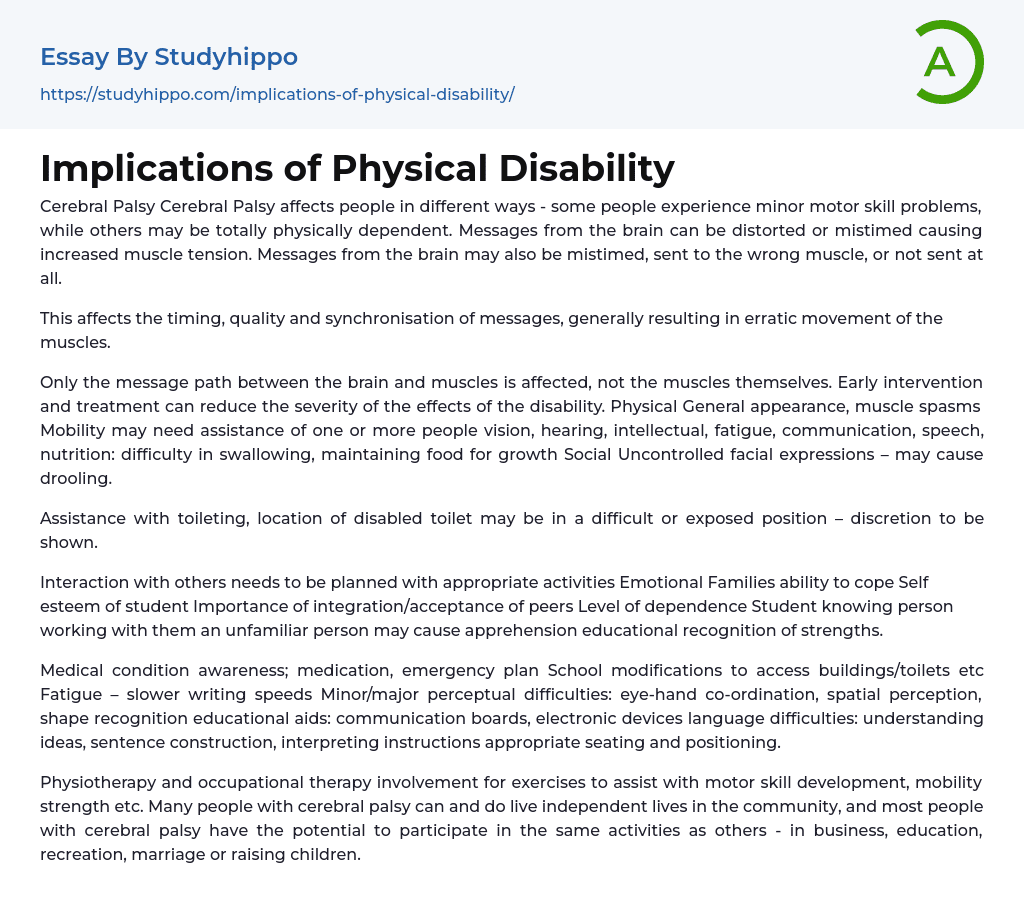Cerebral Palsy Cerebral Palsy affects people in different ways - some people experience minor motor skill problems, while others may be totally physically dependent. Messages from the brain can be distorted or mistimed causing increased muscle tension. Messages from the brain may also be mistimed, sent to the wrong muscle, or not sent at all.
This affects the timing, quality and synchronisation of messages, generally resulting in erratic movement of the muscles.
Only the message path between the brain and muscles is affected, not the muscles themselves. Early intervention and treatment can reduce the severity of the effects of the disability. Physical General appearance, muscle spasms Mobility may need assistance of one or more people vision, hearing, intellectual, fatigue, communication, speech, nutrition: difficulty in swallowing, maintaining food for growth Social Uncontrolled facial expressions – may cause drooling.
Assistance with toileting, location of disabled toilet may be in a dif
...ficult or exposed position – discretion to be shown.
Interaction with others needs to be planned with appropriate activities Emotional Families ability to cope Self esteem of student Importance of integration/acceptance of peers Level of dependence Student knowing person working with them an unfamiliar person may cause apprehension educational recognition of strengths.
Medical condition awareness; medication, emergency plan School modifications to access buildings/toilets etc Fatigue – slower writing speeds Minor/major perceptual difficulties: eye-hand co-ordination, spatial perception, shape recognition educational aids: communication boards, electronic devices language difficulties: understanding ideas, sentence construction, interpreting instructions appropriate seating and positioning.
Physiotherapy and occupational therapy involvement for exercises to assist with motor skill development, mobility strength etc. Many people with cerebral palsy can and do live independent lives in the community, and most
people with cerebral palsy have the potential to participate in the same activities as others - in business, education, recreation, marriage or raising children.
- Emergence essays
- Anxiety Disorder essays
- Post-traumatic Stress Disorder essays
- Insanity essays
- Cold essays
- Addiction essays
- Anatomy and Physiology essays
- Biodegradation essays
- Cancer essays
- Dental Care essays
- Disability essays
- Disease essays
- Disorders essays
- Health Care essays
- Infectious Disease essays
- Inquiry essays
- Intelligence Quotient essays
- Lung Cancer essays
- Medicine essays
- Neurology essays
- Nutrition essays
- Olfaction essays
- Physical Exercise essays
- Public Health essays
- Sex essays
- Women's Health essays
- World health organization essays
- Adhd essays
- Antisocial Personality Disorder essays
- Anxiety essays
- Bipolar Disorder essays
- Depression essays
- Depression And Anxiety essays
- Dyslexia essays
- Learning Disability essays
- Major Depressive Disorder essays
- Mental Disorder essays
- Mental Illness essays
- Psychosis essays
- Schizophrenia essays
- Stress essays
- Suicide essays
- Consciousness essays
- Intelligence essays
- Mindset essays
- Perception essays
- Problem Solving essays
- Resilience essays
- Physical therapy essays
- Psychological Trauma essays




